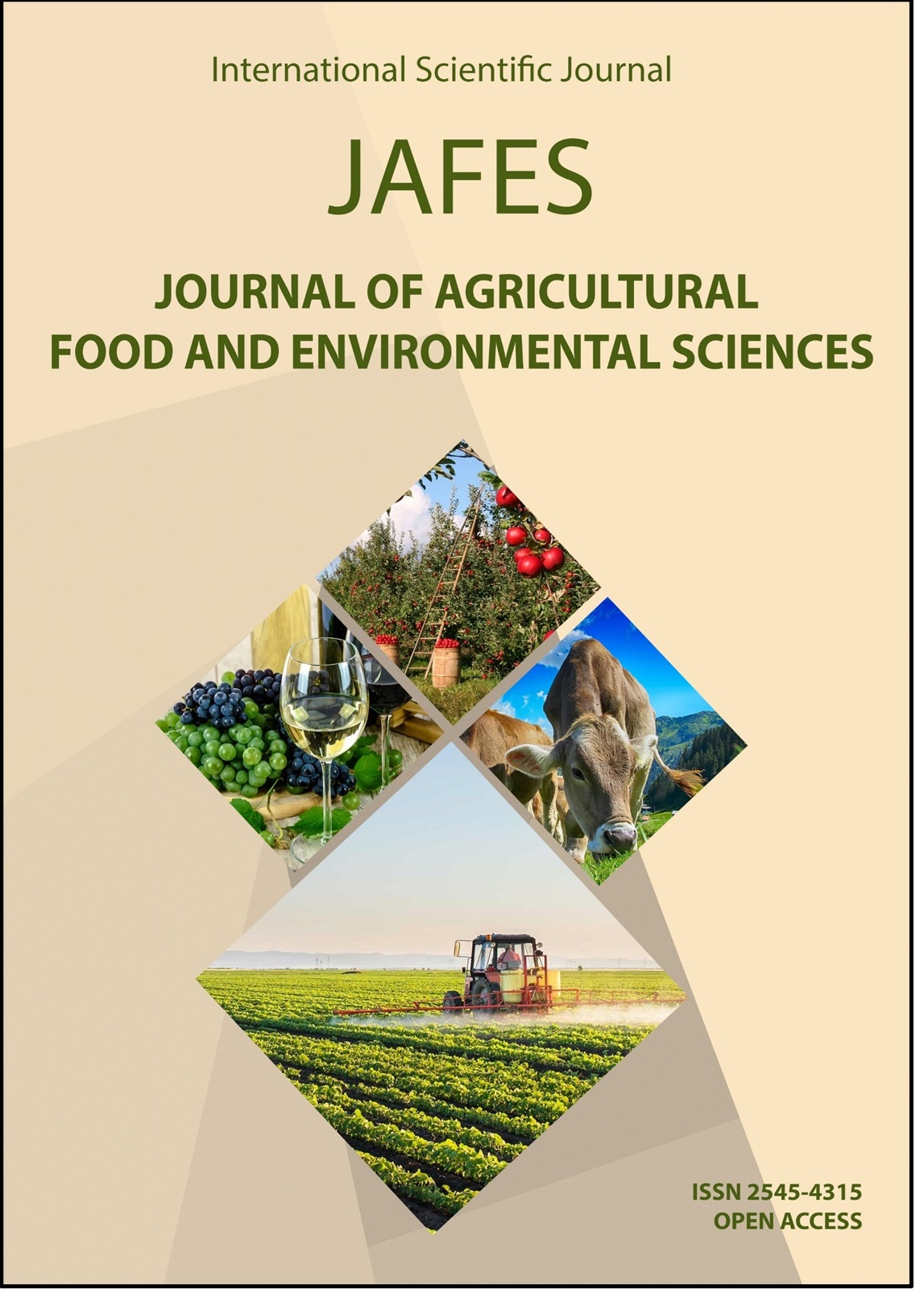BIOLOGICAL CONTROL OF BOTRYTIS BUNCH ROT OF GRAPES IN THE REPUBLIC OF MACEDONIA
Клучни зборови:
biofungicides, Botrytis bunch rot, biocontrolАпстракт
Bunch rot disease of grapes, caused by the necrotrophic fungus Botrytis cinerea is a chronic and serious problem in most of the vineyards in Republic of Macedonia. Its control is mostly achieved by application of synthetic fungicides. However, chemical control of B. cinerea is often difficult and incomplete, especially in vineyards where resistant strains have developed. A promising alternative strategy that could replace or be combined with fungicides are biofungicides. The main goal of the experiment was to observe the possibility for biological control of Botrytis bunch rot disease by the use of three novel biofungicides (Serenade Aso, Polyversum and Timorex gold). Experiment was conducted during the 2016 in two vineyard regions of Republic of Macedonia (Negotino and Kavadarci), on two grape varieties, Chardonnay and Cardinal. The destructive potential of this grape disease was confirmed in the untreated variant of the Chardonnay variety, where the intensity of infection was higher than 48%. Biofungicides Serenade Aso (a.m. Bacillus subtilis QST 713) and
Timorex gold (extract of Malaleuca alternifolia) had similar efficacy, with average of 89% reduction of disease incidence in the region of Negotino and 91,66% in the region of Kavadarci. Biofungicide Polyversum (a.m. Pythium oligandrum M1), applied as preventive sprays achieved more than 85% reduction of the disease in both regions. The results showed that all tested biofungicides have a prospective use for control of bunch rot disease in grapes.
Референци
Abbott W. S. (1925). A method of computing the effectiveness of an insecticide. Journal of Economic Entomology, 18: 265-267.
Dean, R., van Kan, J.A.L., Pretorius, Z.A., Hammond-Kosack, K.E., Di Pietro, A., Spanu, P.D., Rudd, J.J., Dickman, M., Kahmann, R., Ellis, J., Foster, G.D. (2012). The Top 10 fungal pathogens in molecular plant pathology. Mol. Plant Pathol. 13: 414–430.
Diguță, C.F., Matei, F., Cornea, C.P. (2016). Biocontrol perspectives of Aspergillus carbonarius, Botrytis cinerea and Pencillium expansum on grapes using epiphytic bacteria isolated from Romanian vineyards. Romanian Biotechnological Letters 21(1): 11126 11132.
Elad, Y., Vivier, M., Fillinger, S. (2015). Botrytis: the good, the bad and the ugly. In: Fillinger, S., Elad, Y., Vivier, M. (Eds.), Botrytis—the Fungus, the Pathogen and Its Management in Agricultural Systems. Springer, Heidelberg, Germany, pp. 1–15.
Elmer, P.A.G and Reglinski, T. (2006). Biosuppression of Botrytis cinerea in grapes. Plant Pathology 55: 155–177
Esterio M, Auger J, Droguett A, Flanagan S, Campos F. (2000). Efficacy of Bacillus subtilis (Ehrenberg), Cohn., QST-713 Strain (SerenadeTM), on Botrytis cinerea control in table grape (Vitis viniferea L. cv Thomson Seedless). In: Proceedings of the XII International Botrytis Symposium, Reims, France. Europol Agro, Abstract L27.
Harman, E.G., Howell, R.C., Viterbo, A., Chet, I., Lorito, M. (2004). Trichoderma species - opportunistic, avirulent plant symbionts. Nature Reviews Microbiol. 2: 43-56.
Howell, R.C. (2003). Mechanisms employed by Trichoderma species in the biological control of plant diseases: the history of and evolution of current concepts. Plant Disease 87(1): 4-10.
Janisiewicz WJ, Korsten L. (2002). Biological control of postharvest diseases of fruits. Annual Review of Phytopathology 40: 411–441.
Latorre BA, Spadaro I, Rioja ME. (2002). Occurrence of resistant strains of Botrytis cinerea to anilinopyrimidine fungicides in table grapes in Chile. Crop Protection 21: 957–961.
Leroux P. (2004). Chemical control of Botrytis and its resistance to chemical fungicides. In: Elad Y, Williamson B, Tudzynski P, Delen N, eds. Botrytis: Biology, Pathology and Control. Dordrecht, The Netherlands: Kluwer Academic, 195–222.
Leroux P., Fritz R., Debieu D., Albertini C., Lanen C., Bach J., Gredt M., Chapeland F. (2002). Mechanisms of resistance to fungicides in field strains of Botrytis cinerea. Pest Management Science, 58: 876-888.
Couderchet. M. (2003). Benefits and problems of fungicide control of Botrytis cinerea in vineyards of Champagne. Vitis 42 (4): 165–171
Magnin-Robert M, Trotel-Aziz P, Quantinet D, Biagianti S, Aziz A. (2007). Biological control of Botrytis cinerea by selected grapevine-associated bacteria and stimulation of chitinase and β-1,3 glucanase activities under field conditions. European Journal of Plant Pathology 118(1): 43-57.
Aboelghar, M. and Wahab, H.A. (2013). Spectral footprint of Botrytis cinerea, a novel way for fungal characterization. Advances in Bioscience and Biotechnology, 4: 374-382.
van Rooi, C. and Holz, G. (2003). Fungicide efficacy against Botrytis cinerea at different positions on grape shoots. S. Afr. J. Enol. Vitic. 24(1): 11-15.
Rosslenbroich HJ, Stuebler D. (2000). Botrytis cinerea – history of chemical control and novel fungicides for its management. Crop Protection 19: 557–561.
Sergeeva V, Nair NG, Verdanega JR, Shen C, Barchia I, Spooner Hart R. (2002). First report of anilinopyrimidine resistant phenotypes in Botrytis cinerea on grapevines in Australia. Australasian Plant Pathology 31: 299–300.
Sharma RR, Singh D, Singh R. (2009). Biological control of postharvest diseases of fruits and vegetables by microbial antagonists: A review. Biological Control 50: 205–221.
Spadoro D, Gullino ML. (2005). Improving the efficacy of biocontrol agents against soilborne pathogens. Crop Protection 24: 601–613.
Stojanovikj, D., Kostikj, B., Dimitrievikj, B., Ostoikj, N., Mitikj-Muzina, N., Bogavac, M., Tomasevikj, B., Gruikj, G. and Ruzikj A. (1971). Handbook of methods in determining presence, evaluation of presence intensity and calculation ofplant loss caused from plant disease and pests. Secretariat for Agriculture, Belgrade, Serbia.
Townsend, G. R and J. W. Heuberger. (1943). Methods of estimating losses caused by diseases in fungicide experiments. Plant Disease Reporter 27: 340-343.
Trotel-Aziz P, Couderchet M, Biagianti S, Aziz A. (2008). Characterization of new bacterial biocontrol agents Acinetobacter, Bacillus, Pantoea and Pseudomonas spp. mediating grapevine resistance against Botrytis cinerea. Environmental and Experimental Botany. 64(1): 21–32.
Williamson, B., B. Tudzynski, P. Tudzynski, and J. A. L. van Kan. (2007). Botrytis cinerea: the cause of grey mould disease. Molecular Plant Pathology 8: 561-580.



